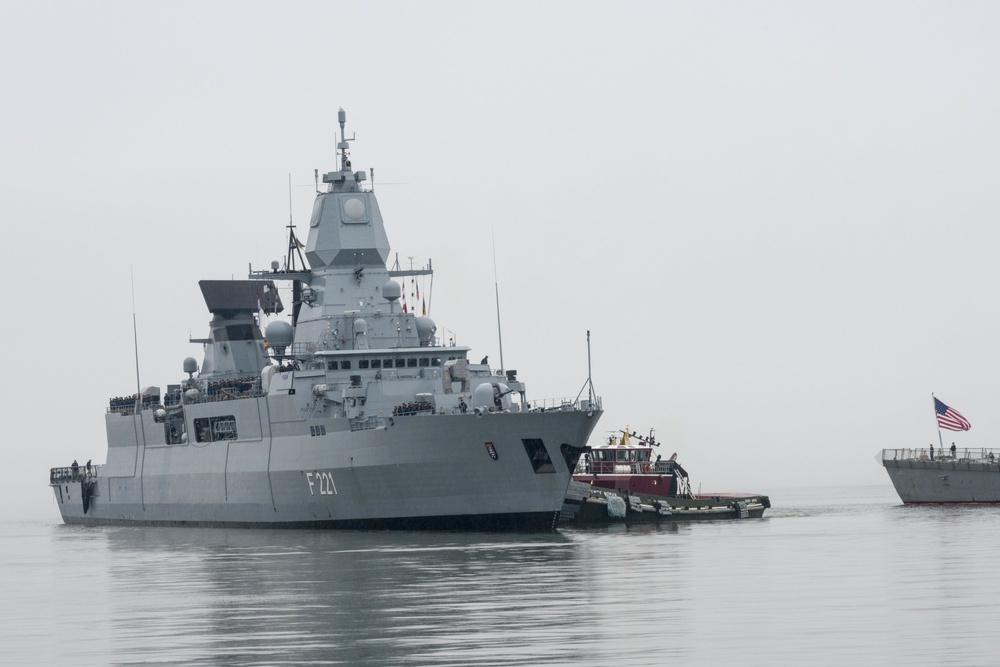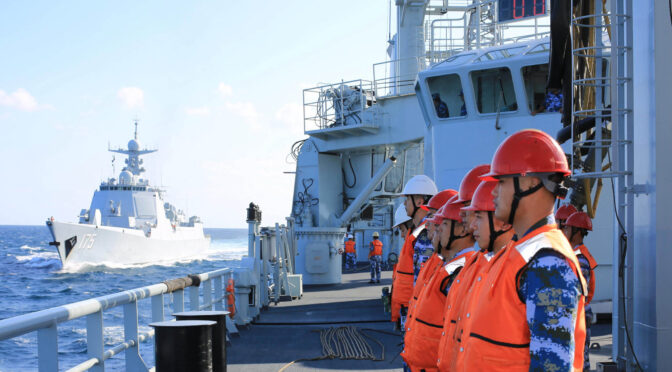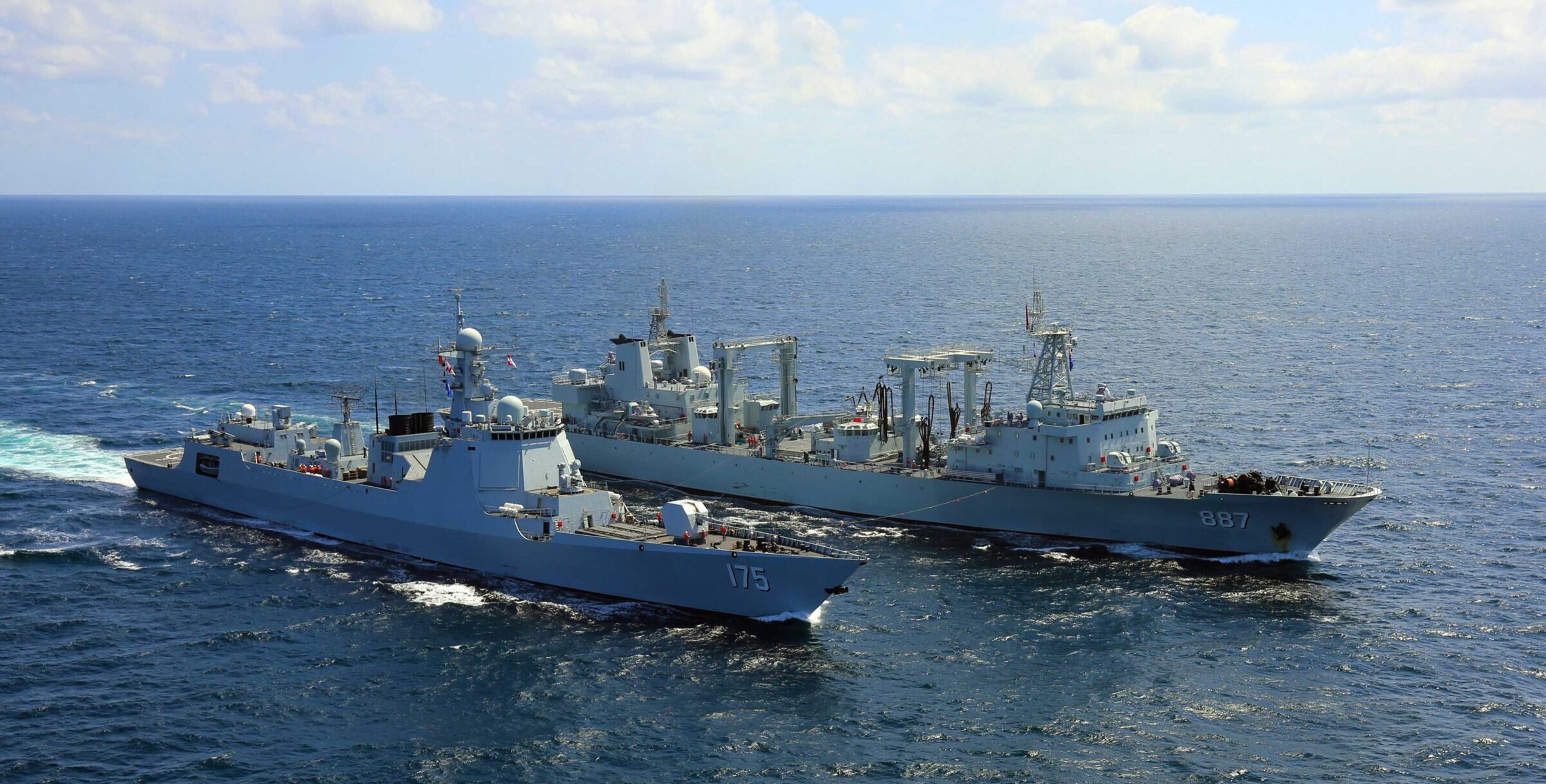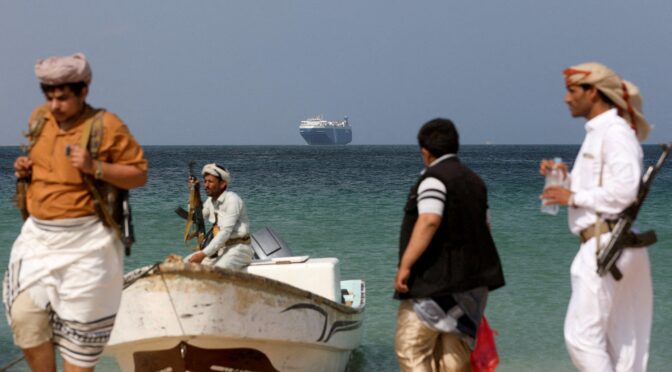By COL Jörg Stenzel, German Army, and CDR Michael Posey, U.S. Navy
Everything in war is very simple, but the simplest thing is difficult. –Carl von Clausewitz
Almost Friendly Fire
In February 2024, a fortunate mishap prevented German Navy air defenders from shooting down an American MQ-9 Reaper in the Red Sea. The frigate misidentified the U.S. drone and fired two Standard Missile 2s at the target – which both subsequently missed. This near-miss incident in the Red Sea and reports about minimal ammunition stocks have triggered many controversial discussions about the German Navy’s capabilities and readiness. These discussions could erode trust—the trust of the German sailors in their professional skills and weapon systems, and the trust of allies and partners. Since trust is the ultimate currency, the impact of this incident demands a closer assessment.
Operations Prosperity Guardian and Aspides: Protecting the Sea Lanes against Houthi Fires
In response to Israel’s Operation Swords of Iron in Gaza, the Houthis, an Iranian-backed rebel group in Yemen, started to attack Israel with drones and missiles. As the Israelis intercepted most attacks, the Houthis changed their strategy. Beginning in November 2023, they attacked commercial ships in the Red Sea, often employing anti-ship missiles, which caused severe damage and forced shipping companies to avoid the Bab el-Mandeb Strait and redirect to a much longer route around Africa. The U.S. formed an international coalition comprising more than 20 nations to protect this critical waterway and launched Operation Prosperity Guardian. In January, the U.S. and Great Britain targeted Houthi positions, and President Biden announced that these strikes were in direct response “to unprecedented Houthi attacks against international maritime vessels in the Red Sea.” On February 19, 2024, the European Union (EU) launched its EU Naval Force (EUNAVFOR) Operation Aspides to protect vessels against ongoing attacks, accompany vessels, and reinforce maritime situational awareness. Unlike its sister mission, Aspides is purely defensive and not authorized to strike in the land domain.
German Defense Minister Boris Pistorius visited the crew of the German Navy warship Hessen in the port of Souda, Creta, shortly before the frigate deployed in their area of operation and said, “The freedom of trade routes and the safety of ships on the most important sea corridor between Europe and Asia are indispensable. […] Germany cannot stand on the sidelines and do nothing.” Protecting the sea lanes has always mattered politically to Germans. For instance, former German President Horst Köhler resigned in 2010 over critiques of his statement that Germany has to be able to secure lines of communication in the global economy.
Fourteen years later, the German Bundestag approved the participation of armed German forces in Operation EUNAVFOR Aspides on February 23, 2024, with 538 out of 573 members of Parliament voting in favor of the mission. Germany’s main contribution to the mission, besides personnel at the Headquarters in Larissa, Greece, and on the flagship, is the guided missile frigate Hessen, seen as its Navy’s “gold standard.”
Modern, Mighty, Mobile: Hessen is State of the Art, yet Misidentified a U.S. Drone
The ship has capabilities in all warfare areas, but its specialty is air defense. The German Ministry of Defense takes pride in the U.S. accepting the ship to provide air coverage for carrier strike group 12 around the USS Gerald R. Ford in 2022. The Hessen has a multifunctional Active Phased Array Radar (APAR) and the long-range air surveillance and detection radar SMART-L to fulfill this role. The latter has a range of 400 km (about 250 miles) and can track up to 1,000 airborne targets at the same time, and the former can detect and track more than 200 targets up to 150 kilometers (about 93 miles). To neutralize airborne threats, the frigate is equipped with one Mk 41 Vertical Launching System for 24 RIM-66 Standard Missiles (SM-2MR) and 32 RIM-162 Evolved Sea Sparrow Missiles (ESSM]), two Mk 49 missile launching systems for RIM-116 Rolling Airframe Missiles (RAM) and an Oto-Melara 76/62 gun. For anti-surface and anti-submarine missions, the ship has a launcher for RGM-84 Harpoon missiles, tubes for EuroTorp MU 90 impact torpedoes, and 27mm autocannon systems. These systems are operated by a command-and-control system with a fully distributed data processing system and a redundant fiberglass data network connecting its sensors and effectors.

On February 26th, the ship detected an Uncrewed Aerial Vehicle (UAV) approaching the Hessen’s area of responsibility with at least 15 merchant ships sailing within the vicinity. The UAV lacked an Identification, Friend, or Foe (IFF) transponder signal. After coordinating with allied units and the relevant command posts in the maritime area, the commander decided to attack. The two designated SM-2 missiles did not destroy the target, which in this case, was good news as the UAV turned out to be a U.S. MQ-9 Reaper.
While the German Joint Forces Operational Command stated that the technical team of the frigate fixed the issue causing the erroneous SM-2 engagements, the German press reacted with sensationalist stories, with one national magazine headline entitled, “The Navy becomes a laughingstock.” Even after the crew later destroyed two Houthi UAVs, the press speculated about further malfunctions of the SM-2 and ESSM weapons because the ship fired its RAM and cannon to down the two drones. Furthermore, commentators questioned the possibility of resupplying the warship with expensive and limited SM-2 and ESSM missiles.
The Chief of the German Navy took a clear position and defended the crew, calling the actions that nearly ended in the destruction of an allied UAV a “textbook solution,” and making a strong statement that he would have acted in the same way. Still, his statement was vague regarding the ammunition concern, simply announcing that the Navy had enough.
Both the SMART-L and APAR radars detected and tracked the possible air threat, showing their functionality. But the systems are of a technical standard from the late 1990s and may have lapsed into obsolesce. More sophisticated systems can compare the electromagnetic signature of a possible target with a database and could have identified the UAV as a Reaper despite the lack of transponder signal. The Navy knew of this problem, and since 2006, the leadership has tried to close the capability gap. The shrinking defense budget and the costly and prioritized operation in Afghanistan and other stabilization missions have prevented the modernization of these naval systems. Finally, in 2021, the Bundeswehr awarded a contract to Hensoldt to integrate an Israeli long-range radar into the frigate, a complex modernization project that will not be finished before 2027.
The Hessen is not the first high-end air defense platform that misidentified an aircraft. In 1988, while patrolling the Persian Gulf, the USS Vincennes (CG-49) shot down a civilian Iranian Airbus, killing 290 passengers. While the modern-for-its-time cruiser, equipped with the new SPY-1A radar and AEGIS weapons system, patrolled the Persian Gulf during the Iran-Iraq War, the ship’s commanding officer believed his ship was under attack by an Iranian F-14.
The fog of war during the incident could be attributed to a lack of communication on the guard distress channel, crew resource management, technical incongruencies, and mounting U.S.-Iranian tensions in the Strait of Hormuz. Developed to “solve the problem of air defense,” the AEGIS weapons system – so named the “Shield of the Fleet” – was supposed to use automation to reduce human error. Instead, innovative technology has introduced different human errors. The Vincennes incident reminds us that technology can never remove the friction inherent in combat. Further, the Vincennes incident demonstrates that tactical-level mistakes, like aircraft misidentification, can have tragic, strategic-level impacts.
Complex Command and Control Begets Cross-Mission Communication Challenges
The misidentification of the MQ-9 also raises questions about the command and control (C2) design of the operations and the situational awareness in the Red Sea and surrounding waters. Overlapping maritime operations and jurisdictions in the wider area, from the eastern coastal area of Eritrea and Ethiopia to the Strait of Hormuz in the west, could have contributed to Hessen’s lack of situational awareness regarding the MQ-9.
The European Union’s Operation Atlanta has an area of responsibility which includes the Gulf of Aden, the Somali Basin, the Red Sea, the Gulf of Suez, and the Gulf of Aqaba. Operation Agenor, also under the umbrella of the European Common Security and Defense Policy, has responsibilities in an area covering the entire Gulf, the Strait of Hormuz, and a part of the Arabian Sea. Under U.S. Central Command, the U.S. Naval Forces Central Command has established Combined Maritime Forces (CMF) with 41 partner nations. CMF includes five operational staffs, including Combined Task Forces (CTF) with regional or functional responsibilities. CTF 153, which focuses on security in the Red Sea, is leading Operation Prosperity Guardian.
Greek Rear Admiral Vasileios Gryparis leads the EU Red Sea mission from his headquarters ashore in Larissa, Greece, and the Italian Force Commander, Rear Admiral Stefano Costantino, embarks on his flagship Federico Martinengo. This Italian frigate was already in the area, providing maritime situational awareness and escorting the merchant ships. The Caio Dulio guided missile destroyer replaced it on February 8, 2024. It is possible the new commander did not establish comprehensive situational awareness and command and control. Interestingly, the Parliament in Rome formally approved the Italian contribution to the mission on March 5, 2024, days after the nearly avoided blue-on-blue incident with the Hessen.
Further exacerbating the issue are disparate C2 of sea and air assets controlled by their nation in Madrid, Rome, or Paris. According to the press release, an indicator of the non-existing overall situational awareness is that the Hessen did not coordinate with the Aspides flagship but directly with CTF 153 to request an update on their airspace picture. The response from their headquarters in Manama, Bahrain, led to the conclusion that the detected UAV must be classified as hostile. As later determined, it was a U.S. asset, so either CTF 153 did not have a clear picture of the situation or could not be shared, possibly because of the compartmental classification of this UAV’s particular mission.

Costly SM-2s and Dwindling Weapon Stocks
Usually seconds after firing long-range air defense missiles, Sailors would see the effects of the interception in the sky over the Red Sea and/or on their combat system consoles. However, the crew kept relatively silent since the two SM-2s did not destroy their target. Analyzing the press statement, which informed us that the crew had solved the technical mishap, it is likely that a problem with the fire control system, APAR, existed. The system is optimized to intercept supersonic bombers, like the Russian Tupolev Tu-22M, and ballistic missiles. The Reaper by comparison has a cruising speed of about 170–200 miles per hour and may not have been correctly targeted by the combat system. Furthermore, the drone flew parallel to the vessel, which can intensify the cross-range effect and needs to be addressed by calibrating the settings of the fire control system. It seems paradoxical that a slow airframe would be an advantage, but history proves otherwise. For example, the British torpedo bombers “Swordfish” attacked the battleship Bismarck in 1941 and flew slowly, which caused severe challenges for the ship’s air defense fire control system.
Frequent live fire exercises could have helped detect the problem earlier. Still, minimal stock and costly unit prices from $500,000 to more than a million U.S. dollars per missile led to just a few meticulously prepared launches under near-laboratory conditions over the last 30 years.
The crew engaged two hostile drones the next day, and reading between the lines of the press releases, there are occasional hints that a first attempt to destroy them with an ESSM missile failed as well, most likely for the same reasons as the mishaps with the SM-2. The crew then successfully destroyed the targets with RAM and the vessel’s cannon, which the press criticized again. The commentators argued that nearly any German Navy vessel could accomplish this mission, indirectly questioning the value of the air defense escort of the specialized Hessen, an exaggerated and inaccurate claim. However, the described combat situation shows that the layered defense concept works and the Hessen crew wisely leveraged its lower-cost munitions as the tactical situation permitted.
For good reasons, the German Ministry of Defense keeps information about ammunition stocks secret. The opposition recently used the tool of a Parliamentary Inquiry to learn more, but most of the answers are classified. A spokesperson of the Christian Social Union party, part of the current opposition, stated: “We have now only learned on inquiry that part of the ammunition of the frigate ‘Hessen’ can no longer be procured because there is no longer the corresponding industrial capacity.” Using the SIPRI Arms Transfer Database, the German Navy is on record ordering 108 legacy and six later variant SM-2s. Taking exercises since then into account, the number of available SM-2s should be somewhere between 65 and 80, which would only be enough to arm the Navy’s three air defense frigates with a single loadout.
Finally, crew training and morale matters. As noted above, the leadership supported the crew’s decision. In cooperation with Navy Command experts, the embarked organic technical personnel detected and fixed the problem, showing the utmost importance of trained, experienced, and motivated sailors. Precisely here, the Navy, as the whole Armed Forces, faces challenges in recruiting and retention that can create a severe readiness problem. Highly skilled experts, like technical support or radar operators, are significantly understaffed, leading to long individual embarkment periods and making the profession unattractive.
The Hessen is an excellent example of the high mission rate. On July 24, 2023, the frigate cast off and became, for six months, the flagship of Standing Naval Maritime Group 1, part of NATO’s Very High Readiness Joint Task Force. Released from this duty in January 2024, on February 8 the vessel sailed to the Red Sea and ended its mission there on April 21, making for a total deployment length of almost nine months.
Frequent and long-duration deployments deeply affect morale and ship maintenance. Furthermore, press commentary that appears to broadcast more malicious ridicule than professional criticism could also undermine recruiting.
Hessen’s Near Miss Refreshes Timeless Lessons for the Modern Warfighter
The German military is at a critical inflection point. Changing national security priorities from financial crises, a costly counterinsurgency mission in Afghanistan, and caring for refugees to investment in large-scale combat operations capabilities proves easier said than done. The German military must make every effort to speed its adaptation, especially by mining the combat experience of the Hessen for extensive lessons.
Situational awareness, effective battlespace management, and well-defined command-and-control are indispensable for effective military operation in every domain. Given the importance of operating with allies and partners, information systems must communicate seamlessly in real time. If for any reason information about assets in the area of responsibility cannot be directly shared, workarounds must be created in advance to avoid incidents like the one described.
Warfighters must train as they would fight. All components of sophisticated weapon systems are costly, but their use must be trained under rigorous combat conditions. Even if a common foundation of doctrine and procedure exists, multinational units need time to train together as a team before going into combat operations. Likewise, backup systems and protocols need to be trained regularly. The latest modern technology can never remove the fog and friction for warfighters at sea, as the Hessen and Vincennes incidents demonstrate. Training using backup systems and going back to basics provides a stronger foundation for dealing with ambiguous combat conditions.
Low stocks are a strategic liability. Purchasing weapon systems is certainly expensive, and the desire to reduce costs is always high, but a complex system of systems will not work for long without deep inventories of essential components. This applies to ammunition, maintenance arrangements, and the real-time availability of spare parts.
There are many questions about Hessen‘s mishaps. Even if the German Navy’s participation in the Red Sea is its most dangerous (combat) mission since the Cold War, it may not be remotely comparable to the challenges of large-scale combat operations, demonstrating the importance of learning from this incident. A political declaration of “Zeitenwende” is not necessarily synonymous with ushering in a new era of combat-ready and modern forces. The blue-on-blue near miss in the Red Sea gives evidence for the timeless Clausewitz dictum that everything in war is simple, but the simplest things can be difficult.
COL Jörg Stenzel is a German Army Armor Officer and CDR Michael Posey is a U.S. Naval Flight Officer. Both currently teach in the Department of Military Strategy, Planning, and Operations at the U.S. Army War College in Carlisle, PA. Both authors’ views are presented in a personal capacity and do not necessarily reflect the official views of any government or military service.
Featured Image: German Navy frigate Hessen (Bundeswehr photo)







